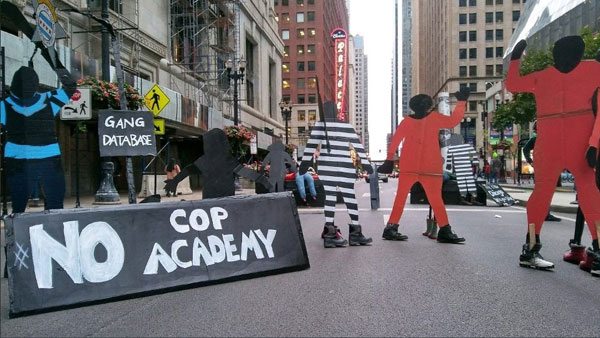
November 8, 2017; Chicago Tribune
In Chicago, as in other large, rapidly changing metropolitan areas, community development projects are often contested and hotly debated. A new campaign led by local activists against a $95 million police training center proposed for the West Garfield Park area has raised new questions about urban revitalization strategies that could impact how nonprofits and foundations align with Black and Brown communities that are organizing to end racial violence.
In a packed city council hearing, community activists and Chance the Rapper delivered a powerful message to Mayor Rahm Emanuel and city aldermen that the training center was not welcome in Chicago. One after another, Chicago leaders vocalized the realities of police violence, recalled the hundreds of millions of dollars of public resources spent on police misconduct cases, and lambasted city council members for closing 50 public schools in their neighborhoods. A series of speeches by youth leaders and longtime residents even circulated as videos on social media.
The large turnout of over 40 organizations reflected the organizing skill and strong support building across the city for the new youth-led No Cop Academy campaign. Repeated calls to fund public schools, youth employment programs, and mental health facilities instead of a 30-acre police center highlighted the anger many feel about the lack of resources in Black and Brown communities amid a disturbing trend in the allocation of funds for urban revitalization in Chicago.
Indeed, apart from learning that hundreds of cases of police misconduct have cost taxpayers over 370 million dollars since 2011, over the past few months Chicagoans have also learned about plans for large-scale development projects surrounding the central business district, totaling an estimated $20 billion. According to an article published by the Chicago Tribune on June 23, 2017,
In Chicago, at least 10 developments that will cost $1 billion or more are already under construction or are backed by high-powered developers that are in advanced planning stages…Among this era’s largest projects are multibillion-dollar ones such as Related Midwest’s $5 billion-plus vision for a 62-acre site along the Chicago River in the South Loop and Sterling Bay’s yet-to-be-unveiled blueprints for more than 40 acres on and around the North Side site where the A. Finkl & Sons steel plant once stood along the river. At least six other projects of $500 million or more are underway or near the starting line, including the Chicago Cubs owners’ redevelopment of Wrigley Field and surrounding properties, a conversion of the long-vacant old main post office into modern offices and retail, and Blackstone Group’s planned retail and entertainment addition onto the base of the city’s tallest building, Willis Tower…Regardless of how they all fare, the sheer number of proposed megaprojects stands out, making this a unique time in Chicago.
While private developers have gotten the green light under the Emanuel administration, the mayor has also worked aggressively to attract corporate headquarters to Chicago. Last month, for example, Chicago and the state of Illinois submitted a joint proposal to Amazon that involved ten sites and an estimated $2 billion in tax incentives. According to one report,
Sign up for our free newsletters
Subscribe to NPQ's newsletters to have our top stories delivered directly to your inbox.
By signing up, you agree to our privacy policy and terms of use, and to receive messages from NPQ and our partners.
Described by many as the biggest tech prize in recent memory, the deal is said to be worth up to $5 billion in investment and 50,000 jobs. In addition to these ten Amazon-friendly locations, the bid is also said to include an incentive package from local, county, and state governments.
One could list a number of other controversial projects that rely upon vast public resources and have brought few benefits to low income and Black and Brown communities. Even more troubling is that high profile community revitalization programs intended to benefit historically neglected communities are reportedly failing.
An October DNAinfo article reported that a $100 million Catalyst Fund led by city Treasurer Kurt Summers has yet to become operational. According to the report,
A year ago, aldermen and Mayor Rahm Emanuel heralded the creation of a $100 million investment fund with taxpayer money, assuring critics that it would breathe new life into the South and West sides of Chicago and help fight crime and blight. But the fund has yet to invest a single dollar.
A three-year and $40 million grant program was announced in September 2017 by JPMorgan Chase, but it’s too early to evaluate the success of the program.
In other words, reports indicate that many Black and Brown communities have experienced broken promises of revitalization and will see miniscule resources in comparison to land and tax investments in private development projects and corporate relocations. That Chicago’s city council is seriously considering approving a $95 million police training center that many community members oppose further exacerbates this already alarming inequality in urban revitalization. Notably, while proponents of the police center frame the project as a reinvestment initiative that will bring jobs and resources to West Garfield Park, the No Cop Academy Campaign is educating the public about the multiple ways that $95 million could be spent to serve the community and not contribute to carceral practices.
For nonprofit organizations and foundations committed to racial justice and equitable community development, the No Cop Academy campaign in Chicago should raise serious questions about the economics, politics, and ethics of police-oriented development projects. More importantly, if elected officials are committed to accomplishing urban revitalization through law enforcement agencies against the will of Black and Brown communities, nonprofit and philanthropic leaders will have to decide with which vision of the revitalized city they are aligned.—Antonio Lopez












